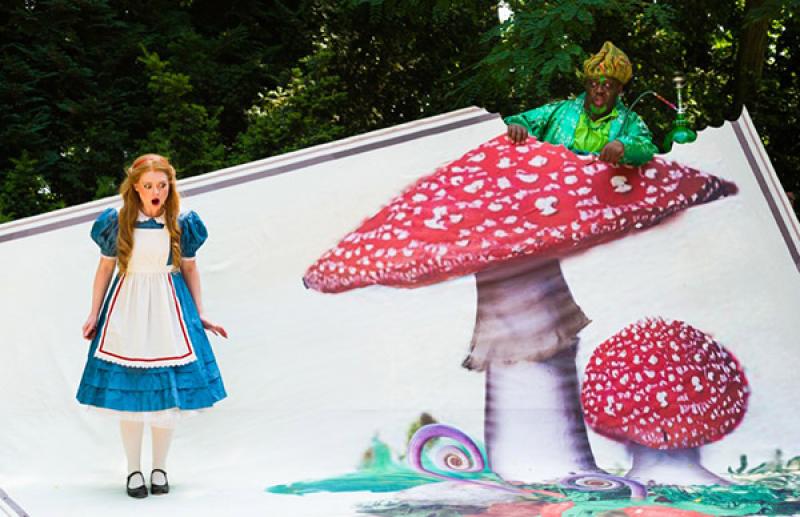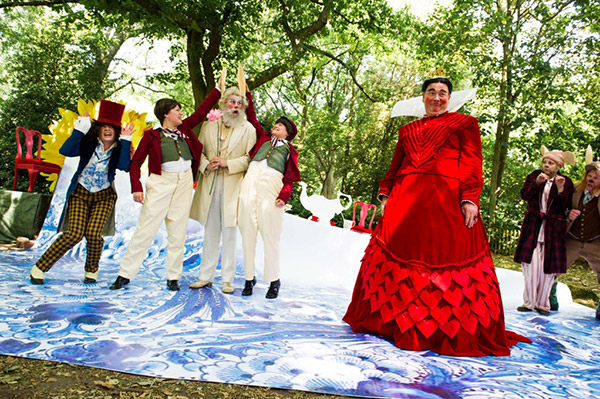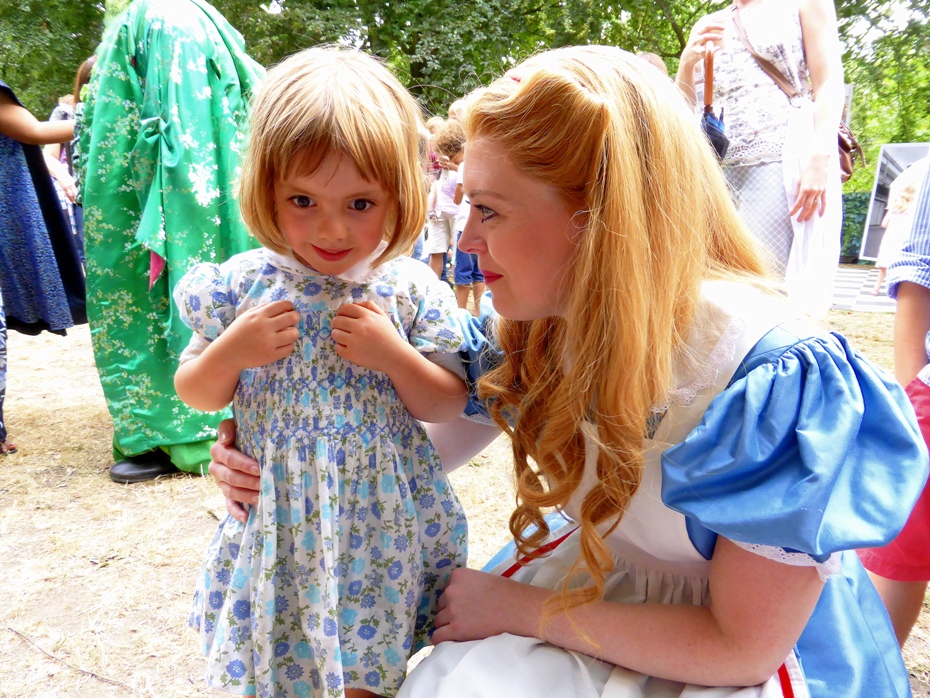Alice's Adventures in Wonderland, Opera Holland Park | reviews, news & interviews
Alice's Adventures in Wonderland, Opera Holland Park
Alice's Adventures in Wonderland, Opera Holland Park
Will Todd's moveabout opera for children of all ages beguiles in a secret garden

“What does opera have to say to the under-30s?” asked Alexandra Coghlan on theartsdesk yesterday. The question “what does opera have to say to the under-10s?” has had to wait until today.
Finland already has it right: the two children’s operas I happened to catch there on two different recent visits made truly operatic demands of the singers and gave the orchestral musicians plenty of rewarding stuff to play. We’re getting there. There was Jonathan Dove's The Adventures of Pinocchio for Opera North, and Todd’s Alice’s Adventures in Wonderland is a shining example, even if the “adventures” aren’t quite what Lewis Carroll had in mind. Maggie Gottlieb’s libretto uses the original text only as a point of departure for further fantasy in a canny mix of Gilbertiana with contemporary references.
 Alice’s dream here is rather more logical than Carroll’s fluid, picaresque journey, entering a world where animals are persecuted by over-rational humans led by a Red Queen (or Queen of Hearts, it doesn't matter) whose murderous intentions are flagged up quite scarily long before “her” appearance. Yet it also offers more of a plot, expertly steered by experienced director Martin Duncan. Christopher Wheeldon's stylish Royal Ballet version was admirably faithful to the first of the two Alice books, but also plagued even in its revision by longueurs and sometimes the victim of its own visual lavishness. Leslie Travers’ designs here are simpler but brilliant, the handful of tricks all offering an old Victorian-style magic which surely delights the kids just as much.
Alice’s dream here is rather more logical than Carroll’s fluid, picaresque journey, entering a world where animals are persecuted by over-rational humans led by a Red Queen (or Queen of Hearts, it doesn't matter) whose murderous intentions are flagged up quite scarily long before “her” appearance. Yet it also offers more of a plot, expertly steered by experienced director Martin Duncan. Christopher Wheeldon's stylish Royal Ballet version was admirably faithful to the first of the two Alice books, but also plagued even in its revision by longueurs and sometimes the victim of its own visual lavishness. Leslie Travers’ designs here are simpler but brilliant, the handful of tricks all offering an old Victorian-style magic which surely delights the kids just as much.
The real pleasure is in everyone, musicians included, making four moves around the garden, the children happily adapting to take their places right at the front where few move around or fidget (Mirabel did flee back to mum in alarm at the appearance of the Red Queen). We begin in black, white and grey contemporary “Grimthorpe” – no first “e” so as not to offend the home of one of Britain’s best bands – with Alice, her parents and her greedy brat brothers, ripe for metamorphosis as Dum and Dee, taking shelter from the rain in a pet shop. The White Rabbit in the cage (James Cleverton) can sing, so why, Alice wonders, can’t he let himself out? Lack of opposable thumbs, slow evolution, he declares. So she lets him loose and the adventures begin, involving time travel back to the Victorian era.
Musically the idiom is jazz meshed with Sondheimish pauses for lyrical thought and some creepy mood music for what’s wrong in Wonderland. There’s a coloratura-soprano “drink me” bottle (Maud Millar), a counter-tenor Cheshire Cat (Magid El-Bushra) whose grin appears on a stick when his blue personage disappears – and who scared the hell out of a toddler in the after-show mingling – and a laid-back, ganja-loving (one presumes) Caterpillar, the marvellous Keel Watson, whose “Wonderland Blues” are the highlight of the opera, for me at any rate.
After the first three picture postcards, we spend longer under the trees with the wind made audible through them and sun dappling the shadowier scene at the Mad Hatter’s steeply-raked tea party. It's here that the Red Queen (Robert Burt, Alice’s dad in drag, very amusing) first shows up (pictured above). There’s a rather beguiling aria of all things beginning with “H” from Patricia Orr’s Duchess, metamorphosed from didactic Humpy Dumpty – I assumed she was the White Queen, but it doesn’t matter here – and seeking old love Hatter (Victoria Simmonds) and the only song adapted from the original for John Lofthouse’s White Knight, distracting a few kids from Alice's pretty, big monologue as he appears on the lawn with a kettle on his head behind the audience.
 The denouement is witty and swiftly done: animals put to work in the Queen’s “kitchen from hell” rise up and find out that the executions were a mere house-of-cards threat; everyone sings a big, somewhat sub-Sondheim number before the “it was only a dream, or was it?” epilogue.
The denouement is witty and swiftly done: animals put to work in the Queen’s “kitchen from hell” rise up and find out that the executions were a mere house-of-cards threat; everyone sings a big, somewhat sub-Sondheim number before the “it was only a dream, or was it?” epilogue.
There’s plenty to sustain the interest. Fflur Wyn, most delightful of light lyric sopranos, charms or channels the childrens’ disquiet throughout, as Alice: no wonder she was Mirabel’s favourite (we got to meet her afterwards, pictured above). Second and third in her books were the Cat, who sang some funny things, and the “Capertillar”, who sang some more she couldn’t quite understand but liked all the same.
The 11-piece “Alice band”, conducted yesterday by Natalie Murray Beale, has various textures: dark and rumbly for the blues, brass-punchy for the Queen’s music, adding a bit of dissonant spice to Alice's moments of confusion or despair, and while the players carry their chairs and the crowd moves on the continuity is provided by a Victorian choral quartet. I’d love to say go see it where you can, but – unlike the Bubble Theatre, whose Alice Through the Looking Glass provided equal site-specific magic some years back – this team isn’t going on tour. Next year, perhaps: this one should run and run.
rating
Share this article
The future of Arts Journalism
You can stop theartsdesk.com closing!
We urgently need financing to survive. Our fundraising drive has thus far raised £49,000 but we need to reach £100,000 or we will be forced to close. Please contribute here: https://gofund.me/c3f6033d
And if you can forward this information to anyone who might assist, we’d be grateful.

Subscribe to theartsdesk.com
Thank you for continuing to read our work on theartsdesk.com. For unlimited access to every article in its entirety, including our archive of more than 15,000 pieces, we're asking for £5 per month or £40 per year. We feel it's a very good deal, and hope you do too.
To take a subscription now simply click here.
And if you're looking for that extra gift for a friend or family member, why not treat them to a theartsdesk.com gift subscription?
more Opera
 La bohème, Opera North review - still young at 32
Love and separation, ecstasy and heartbreak, in masterfully updated Puccini
La bohème, Opera North review - still young at 32
Love and separation, ecstasy and heartbreak, in masterfully updated Puccini
 Albert Herring, English National Opera review - a great comedy with depths fully realised
Britten’s delight was never made for the Coliseum, but it works on its first outing there
Albert Herring, English National Opera review - a great comedy with depths fully realised
Britten’s delight was never made for the Coliseum, but it works on its first outing there
 Carmen, English National Opera review - not quite dangerous
Hopes for Niamh O’Sullivan only partly fulfilled, though much good singing throughout
Carmen, English National Opera review - not quite dangerous
Hopes for Niamh O’Sullivan only partly fulfilled, though much good singing throughout
 Giustino, Linbury Theatre review - a stylish account of a slight opera
Gods, mortals and monsters do battle in Handel's charming drama
Giustino, Linbury Theatre review - a stylish account of a slight opera
Gods, mortals and monsters do battle in Handel's charming drama
 Susanna, Opera North review - hybrid staging of a Handel oratorio
Dance and signing complement outstanding singing in a story of virtue rewarded
Susanna, Opera North review - hybrid staging of a Handel oratorio
Dance and signing complement outstanding singing in a story of virtue rewarded
 Ariodante, Opéra Garnier, Paris review - a blast of Baroque beauty
A near-perfect night at the opera
Ariodante, Opéra Garnier, Paris review - a blast of Baroque beauty
A near-perfect night at the opera
 Cinderella/La Cenerentola, English National Opera review - the truth behind the tinsel
Appealing performances cut through hyperactive stagecraft
Cinderella/La Cenerentola, English National Opera review - the truth behind the tinsel
Appealing performances cut through hyperactive stagecraft
 Tosca, Royal Opera review - Ailyn Pérez steps in as the most vivid of divas
Jakub Hrůša’s multicoloured Puccini last night found a soprano to match
Tosca, Royal Opera review - Ailyn Pérez steps in as the most vivid of divas
Jakub Hrůša’s multicoloured Puccini last night found a soprano to match
 Tosca, Welsh National Opera review - a great company reduced to brilliance
The old warhorse made special by the basics
Tosca, Welsh National Opera review - a great company reduced to brilliance
The old warhorse made special by the basics
 BBC Proms: The Marriage of Figaro, Glyndebourne Festival review - merriment and menace
Strong Proms transfer for a robust and affecting show
BBC Proms: The Marriage of Figaro, Glyndebourne Festival review - merriment and menace
Strong Proms transfer for a robust and affecting show
 BBC Proms: Suor Angelica, LSO, Pappano review - earthly passion, heavenly grief
A Sister to remember blesses Puccini's convent tragedy
BBC Proms: Suor Angelica, LSO, Pappano review - earthly passion, heavenly grief
A Sister to remember blesses Puccini's convent tragedy
 Orpheus and Eurydice, Opera Queensland/SCO, Edinburgh International Festival 2025 review - dazzling, but distracting
Eye-popping acrobatics don’t always assist in Gluck’s quest for operatic truth
Orpheus and Eurydice, Opera Queensland/SCO, Edinburgh International Festival 2025 review - dazzling, but distracting
Eye-popping acrobatics don’t always assist in Gluck’s quest for operatic truth

Add comment